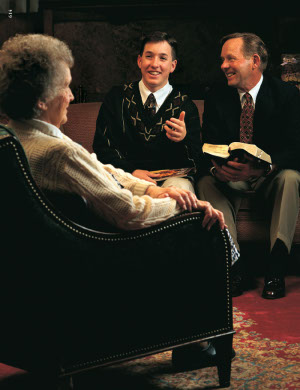Needs-Based Home Teaching
 |
| Rockin’ vest, Brother Jones. |
In late 2011, I was serving as elders quorum secretary in the ward with the lowest activity rate in our stake. Because of our low activity rates, there were dozens of families—literally hundreds of people—who didn’t have home teachers assigned. In many cases, no one even knew who they were!
I’m not sure if the directive came down from the stake president or if a suggestion was made at the ward level and approved by the stake, but we revamped our home teaching program completely, using the following counsel from the Church Handbook of Instructions, Book 2, §7.4.2:
“Quorum and group leaders assign the most effective home teachers to members who need them most. When assigning home teachers, leaders give highest priority to new members, less-active members who may be the most receptive, and others who have the greatest need for home teachers, such as single parents, widows, and widowers.”
When submitting the ward’s quarterly report, the Church requests the “number of families visited by home teachers during the quarter.” Combining this with the above-quoted policy, we were inspired to make the following adjustment: if a family was fully active in the Church and had a Melchizedek Priesthood holder in the home, home teachers should only visit quarterly except in case of special need. This would allow each companionship to focus on those “who need them most,” which we would determine by assigning home teachers to every single family within our stewardship, period. No exceptions.
We started by getting a subscription to PeopleSmart, so we could get some kind of information about those members that nobody knew. I printed a PDF of all known contact information for each family, so we could hopefully track them down later. Once this was complete, we divided the ward into eight geographic areas and outlined them using an online mapping service that allows you to superimpose lines and shapes over Google Maps. (I honestly don’t remember what it was called, but Google now has its own version called My Maps.) We uploaded a list of every member within our jurisdiction, so we could see who lived in which area. Armed with this information, I built an offline database (using the same comma-separated text file as a basis) and added the area number, 1-8, to each record; then manually flagged each member that would be called as a home teacher, so we could divvy up the assignments accordingly.
Home teaching companionships were formed by putting together elders that lived in the same (or occasionally adjoining) geographic areas. We then used a drag-and-drop interface I built, to assign each companionship families that lived in, or very close to, their area(s). When we were done, each companionship had six families, with two exceptions: first, there were two brethren who didn’t live near anyone, one of them living at the extreme northwest corner of the ward and the other at the extreme southwest corner. We assigned them to be companions and gave them five families that lived fairly close to the highway between their respective homes. Second, it turned out that there were four less-active families that lived the next street over from me, so my companionship was assigned all four of them, plus another three that were farther from home.
Once the assignments were made, the quorum president took the first Sunday of the following month to pass out our assignments and explain our directive: each companionship was to visit less-needy families (i.e. fully active, with a Melchizedek Priesthood holder in the home) once per quarter, or as needed; and more-needy families (i.e. everyone else) on a monthly basis. Those companionships that were assigned to someone that nobody knew (which was just about all of us) received a printout of the PeopleSoft information for these families and were told to find them and report back within the month. We were to call all known phone numbers, visit all known addresses within reason, try to track them down on Facebook or Google, basically just do whatever it takes to find these lost sheep and, if possible, bring them home.
It wasn’t long before the activity rate in our ward shot up considerably. Quite a few families had moved out of the ward and were therefore transferred to their local units, who could actually serve them. A handful rebuffed the home teachers and requested no contact or even name removal. But about a dozen less-active members were thrilled by the contact and started becoming more active. Some inactive elders returned to the fold and were added to the list of home teachers. Part-member families became full-member families as nonmember spouses and/or children were baptized. Within six months, each companionship was down to one or two active families and two or three less-active, for a total of four per companionship—at least one of which did not require a monthly visit.
Of course, none of this lets you see behind the curtain, the difference it made in people’s lives. In the 2½ years I served as a home teacher to my four remaining families, two went through divorces; one lost a home to foreclosure; one had major medical problems; one suffered from chronic underemployment and received food orders both from home teachers and from the Bishop’s Storehouse—an option they hadn’t even known was available. Two of these families hadn’t had home teachers for years before my companion and I were assigned to them, and I can assure you that the blessing of serving them was very much ours.
So, there’s my treatment of how needs-based home teaching worked for us. If you think it will work for your ward, then by all means “Go, and do thou likewise” (Luke 10:37).

Comments
Post a Comment